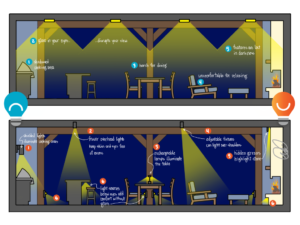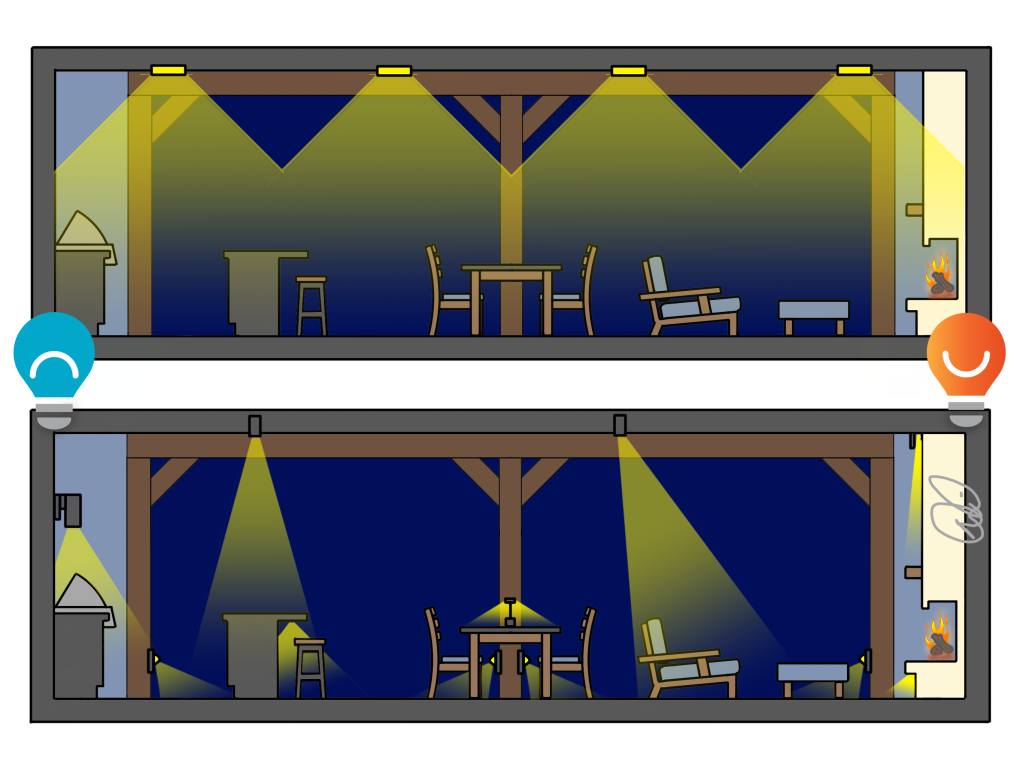For many years, nicer homes would have had a patio or deck behind the house to enjoy during the “season,” which might be summer in Wisconsin or winter in Florida. The patio or deck usually contained some outdoor furniture in wood or painted steel to resist the elements, and perhaps a table with an umbrella to block the sun.
Over time, we added areas for grilling out, added screens in buggy areas, and maybe added a fire pit or fireplace to extend the seasons.
Today, we see a large number of outdoor living spaces come across our desks that go even further, containing nearly complete functioning kitchens, heaters, retractable screens, upholstered furniture, bar counters, televisions, and more. The line between indoor living and outdoor living becomes blurred; in some projects the literal walls that separate them disappear to allow continuous flow between.
It would be easy to simply advise our clients to illuminate their outdoor kitchens like an indoor kitchen, their outdoor living areas like an indoor living room, and their outdoor dining areas like their indoor dining room. Sure, we would need fixtures that could hold up a little better against the rain and dirt, but with full ceilings covering many of the outdoor living spaces, even that can be a minor adjustment.
But to light the outdoor spaces the same as the indoor spaces would be to miss one key element: the elements. Why do we want an outdoor living space, after all? It certainly is not to escape the weather, but rather to enjoy it. We love the fresh air, the cool breeze, the sounds of birds and neighbors and wind rustling in trees.
We also love the warm sunshine, the beautiful sunsets, and the dark night skies that make outdoor living different from indoor living. If we light our outdoor spaces the same as our indoor spaces, we run the risk of making these spaces more artificial and less natural, effectively working against the very benefits that draw us outside.
So what can we do to have the right light outdoors? There are a few ideas that come to mind:
- Rely on natural light as much as possible. Natural light is the best light for our bodies and minds and our planet- and it is a big part of what makes outdoor living enjoyable. When we over-light outdoor spaces, we run the risk of making our natural spaces much more artificial.
- Let your eyes adjust naturally with sunset. Without electric light, the irises in our eyes will gradually open to make it easier to see in the darkness. Too much electric light will keep our irises from adjusting naturally, making it seem darker outside and opening us up to more glare.
- Preserve natural darkness as much as possible. Night is pretty awesome, and our bodies need it to fully relax. We can benefit from keeping our outdoor living spaces as dark as possible, using fewer bright overhead lights, depending more on low-level path lighting, choosing shielded light fixtures that reduce glare, and dimming lighting as low as we can.
Let’s see how these principles play out in a typical covered outdoor living area.

Too often, we illuminate our outdoor spaces with grids of recessed downlights (or worse, disc/wafer lights). This approach disconnects us from nature, so a different method is needed to help us enjoy being outdoors more often and for longer duration.
- Don’t put downlights behind the cooking areas or between countertops; do use shielded lights directly overhead. It is hard enough to tell when the food on the grill is done without casting shadows, so think about how to get uninterrupted light where you need it. I’m showing cylinder wall sconces that hide the light source and direct light downwards; these are low enough that there will be much less glare in your eyes than an overhead downlight might produce.
- Don’t use tidy rows of recessed downlights or disc lights; do use recessed lights in precise locations. Bright overhead lights will put the most glare in your eyes, which will cause your irises to close and keep you from fully enjoying night skies or sunsets. A few carefully placed lights, like over the kitchen island or dining table, will put light where needed. Add a dimmer so you can use just the right amount and no more.
- What is on every table in a nice, comfortable restaurant? A candle or miniscule lamp. Outdoors, overhead lighting on the dining table can be the least comfortable, so consider rechargeable portable table lamps that give you light to see your food or games but put very little light directly into your eyes. A little bit later in this post I will look at a few of these rechargeable lanterns in more detail; I absolutely love this technological advancement!
- Don’t put lights directly above seating areas; push them to over the shoulders instead. Direct downlights above us are in the most glare-sensitive portion of our vision, our peripheral vision. We may have “enough” light to see in this arrangement, but it will distract from our comfort. Instead, consider placing recessed adjustable (aimable) downlights just over the shoulder – beside and behind – the eyes of those seated. You will deliver good light to their books or snacks or knitting while reducing glare and increasing comfort.
- Don’t ignore features; do hide lighting that accents features. Stone fireplaces and timber framing can be quite expensive and beautiful, so why leave them completely in the dark? We want a little bit of light surrounding us at night for comfort, and often these details make the perfect surface for reflecting soft light into our spaces. In this example, I’ve hidden a linear “grazer” light that picks up the natural texture of the stone fireplace.
- Don’t light only from above; do use lighting down low to illuminate pathways. This is perhaps the most important layer of light for enjoying outdoors: just enough light to comfortably navigate through a space, all of it far below your eyes to cut down on glare. I’m showing light underneath the bar top and fireplace hearth as well as a series of recessed step lights embedded in the columns. These lights will often be the only lights needed in your outdoor living space.

If you have read any of my other Don’t/Do This series, you have seen a number of lighting plan views just like the one above. On the Don’t side are often nice, clean rows of recessed downlights, while the Do This side appears a bit messy. This represents a continual challenge for lighting designers: convincing clients that tidy overhead geometry results in bad lighting.
- Don’t put light over seating areas; do light over the shoulders. As mentioned above, this will be more comfortable for those seated. It does require knowing beforehand where furniture will be placed, but often features like fireplaces will help determine where seating will be. Using adjustable lighting can provide flexibility down the road, allowing you to re-aim the lights where needed if you change seating arrangements.
- Don’t leave tables completely in the dark; do use focused downlighting or, better yet, rechargeable table lamps. A good rechargeable lamp or two (see more below) can provide glare-free illumination with the added benefit of complete flexibility – move the table to a new location and the lights move with it.
- Don’t use tidy rows of recessed downlights; do place recessed downlights carefully where they will do the most good. Here you see that the downlights in the Don’t side will do a good job of lighting the empty spaces where no one sits, cooks, or entertains. In the Do plan, note how lights are carefully aligned with the island bar. There will plenty of light to move around between the table and island, but without glare.
- Don’t leave cooking areas shadowed; do use below-the-eye counter lighting whenever possible. Lights behind you will always cast a shadow where you need the best light. Using shielded wall sconces directly over the countertop will push good light down while keeping your eyes free of glare.
- Don’t leave steps dark; do use low-level lighting for paths. Recessed step lights, most often seen outdoors near stairways, work very well indoors and out. Strategically locating them near steps and doorways/openings will allow you and your guests to move about comfortably while preserving what we love about outdoor living – natural light.
- Don’t ignore architectural features; do put light on the interesting things in your space. Calling attention to the details that make your home unique, like the stone of a fireplace or timber framed openings, does double-duty: it bounces soft, glare-free light into the room for your use and allows you to enjoy the features of your home after sunset.

A few years ago, I saw rechargeable table lanterns (similar to C above) begin to appear in nicer restaurants. I needed light at my dining room table, and these seemed the perfect solution. But when I found out how much they cost, I went instead with what I could find easily and cheaply, something like D above that added a glow to the table. I was never satisfied, but it did help.
Today there are many different styles of rechargeable table lamps at wildly different price points. Beautiful machined-brass fixtures can grace the fanciest of tables, while $30 fixtures from online retailers can bring similar light to nearly any table. Is there one style that works better?
I like trying new lighting, so I bought several styles (A, B, & D) and tried them out at home. I quickly returned style A. I liked the look, but it was a little tall (blocking the view of people across the table) and the light coming out of the top was uncomfortable in my eyes. D sits unused in my basement, but B is in use nearly every night (and we even started to use them at lunchtime). These almost disappear, and the low height makes it easy to chat with my family and friends. That also means the light is essentially glare-free, and it’s tunability means I can have warm white in the evening and cooler light at lunch. I love them, indoors and out.
In fact, for the ultimate in outdoor living, I now take them with me when I go camping. There is awesome light on the table without glare, and they can even double as path lights between the camper and the fire. These will be a staple for years to come, I expect.
There are many ways to light outdoor living areas, but the point of being outside is that it is different than inside, more natural, more fresh. The right lighting can help you enjoy the outside better and longer; the wrong lighting can chase you indoors sooner. Keep light out of your eyes, out of the skies, and down low only where needed. And pass me a marshmallow, please?
Read more of my Don’t/Do This series HERE.
